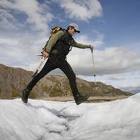 The territories are not capped, of course, only in winter. Regions of Araucania and Patagonia have perpetual snow, ie, cover their mountainous areas throughout the year. Even elsewhere in the world unless you can find snow cold in summer, but will be an old snow, debris left in height of the winter season. Therefore, either hiking or trekking in the winter and summer version, it is known as running in snow.
The territories are not capped, of course, only in winter. Regions of Araucania and Patagonia have perpetual snow, ie, cover their mountainous areas throughout the year. Even elsewhere in the world unless you can find snow cold in summer, but will be an old snow, debris left in height of the winter season. Therefore, either hiking or trekking in the winter and summer version, it is known as running in snow.
It will be useful then to know the types of snow, because each has a feature that involve a type of foot traffic or another. In any case, the key to know is that a patch of snow is more or less hazardous depending on its hardness, the slope of the ground cover, texture and relief of its surface, and the consequences involving a fall on it. Thus, one should bear in mind that:
- The hardness or consistency of the snow, regardless of type, will vary throughout the day depending on the heat that is exposed due to sunlight it receives.
- We should not move (if we do not have crampons) the footprint of our footwear is not marked in the snow (snow very hard, like ice, capable of falling).
- We must not cross a snowfield in the pending case involving a serious fall injury or certain death, if they have no means of assurance. This means that we should go for it if, in case of slip, will not have time, type of snow or enough room for (for fall) autodetención maneuvering (on the other hand, it is mandatory to know).
- Know the basic maneuver autodenteción have practiced before sloping snowfields transit. That is, turn around to know as we fall back and get on all fours, clutching hands and legs to stop our fall. If wearing ax or ax, will need to know autodetención maneuvers with this tool, or else take it without the leash on, to let go when dropped.
- We carry all the body covered with clothing, especially your hands with heavy gloves and long pants legs: if they fall, snow can burn bare skin like asphalt (in fact, as glass does, because its structure is the same as glass).
- When you cross, there should be (as always) the center of gravity over our feet, not out of this line through the middle of the hip. This means we do not have to bend over (back and hip must be extended, right) too far to the mountain to the valley (except when needed to climb using your hands, hands with gloves due to snow), which could cause us to lose balance due to the weight of your backpack or loss of a foothold respectively.



